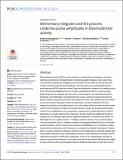| dc.contributor.author | Subramanian, Sandya | |
| dc.contributor.author | Purdon, Patrick L | |
| dc.contributor.author | Barbieri, Riccardo | |
| dc.contributor.author | Brown, Emery N | |
| dc.date.accessioned | 2021-10-27T19:51:58Z | |
| dc.date.available | 2021-10-27T19:51:58Z | |
| dc.date.issued | 2021-07 | |
| dc.identifier.uri | https://hdl.handle.net/1721.1/133293 | |
| dc.description.abstract | <jats:p>Electrodermal activity (EDA) is a direct read-out of sweat-induced changes in the skin’s electrical conductance. Sympathetically-mediated pulsatile changes in skin sweat measured as EDA resemble an integrate-and-fire process, which yields an inverse Gaussian model as the inter-pulse interval distribution. We have previously showed that the inter-pulse intervals in EDA follow an inverse Gaussian distribution. However, the statistical structure of EDA pulse amplitudes has not yet been characterized based on the physiology. Expanding upon the integrate-and-fire nature of sweat glands, we hypothesized that the amplitude of an EDA pulse is proportional to the excess volume of sweat produced compared to what is required to just reach the surface of the skin. We modeled this as the difference of two inverse Gaussian models for each pulse, one which represents the time required to produce just enough sweat to rise to the surface of the skin and one which represents the time requires to produce the actual volume of sweat. We proposed and tested a series of four simplifications of our hypothesis, ranging from a single difference of inverse Gaussians to a single simple inverse Gaussian. We also tested four additional models for comparison, including the lognormal and gamma distributions. All models were tested on EDA data from two subject cohorts, 11 healthy volunteers during 1 hour of quiet wakefulness and a different set of 11 healthy volunteers during approximately 3 hours of controlled propofol sedation. All four models which represent simplifications of our hypothesis outperformed other models across all 22 subjects, as measured by Akaike’s Information Criterion (AIC), as well as mean and maximum distance from the diagonal on a quantile-quantile plot. Our broader model set of four simplifications offered a useful framework to enhance further statistical descriptions of EDA pulse amplitudes. Some of the simplifications prioritize fit near the mode of the distribution, while others prioritize fit near the tail. With this new insight, we can summarize the physiologically-relevant amplitude information in EDA with at most four parameters. Our findings establish that physiologically based probability models provide parsimonious and accurate description of temporal and amplitude characteristics in EDA.</jats:p> | en_US |
| dc.language.iso | en | |
| dc.publisher | Public Library of Science (PLoS) | en_US |
| dc.relation.isversionof | 10.1371/journal.pcbi.1009099 | en_US |
| dc.rights | Creative Commons Attribution 4.0 International license | en_US |
| dc.rights.uri | https://creativecommons.org/licenses/by/4.0/ | en_US |
| dc.source | PLoS | en_US |
| dc.title | Elementary integrate-and-fire process underlies pulse amplitudes in Electrodermal activity | en_US |
| dc.type | Article | en_US |
| dc.contributor.department | Harvard University--MIT Division of Health Sciences and Technology | |
| dc.contributor.department | Massachusetts Institute of Technology. Institute for Medical Engineering & Science | |
| dc.contributor.department | Massachusetts Institute of Technology. Department of Brain and Cognitive Sciences | |
| dc.contributor.department | Picower Institute for Learning and Memory | |
| dc.relation.journal | PLOS Computational Biology | en_US |
| dc.eprint.version | Final published version | en_US |
| dc.type.uri | http://purl.org/eprint/type/JournalArticle | en_US |
| eprint.status | http://purl.org/eprint/status/PeerReviewed | en_US |
| dc.date.updated | 2021-08-11T12:23:10Z | |
| dspace.orderedauthors | Subramanian, S; Purdon, PL; Barbieri, R; Brown, EN | en_US |
| dspace.date.submission | 2021-08-11T12:23:12Z | |
| mit.journal.volume | 17 | en_US |
| mit.journal.issue | 7 | en_US |
| mit.license | PUBLISHER_CC | |
| mit.metadata.status | Authority Work and Publication Information Needed | |
